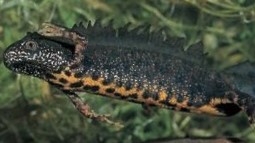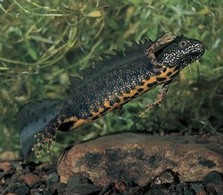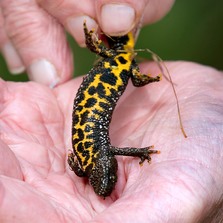

Biodiversity
Action
Plan

Great Crested Newt, Triturus cristatus. Great Crested Newts (GCN) had a considerable population decline in the twentieth century, They were lost from many sites as a result of the removal or deterioration of farm ponds due to more intensive agriculture.
Great Crested Newts need larger and deeper ponds than most other UK amphibians. Ditches and other water bodies may be used.
After mating, females lay hundreds of individual eggs on the leaves of pond plants. Each egg is wrapped up in pond plant leaves and/or pond detritus for protection. Larvae develop over summer to emerge in August – October, normally taking 2–4 years to reach maturity.
For much of the year newts are terrestrial, ranging a considerable distance from breeding sites. They are mainly active at night and feed on invertebrates.
They require rough grassland, scrub or hedgerow or woodland to hunt their prey, take refuge from predators, and over-winter. In the winter they partially hibernate, sheltering under rocks, in old walls, under log-piles and in holes in banks, emerging in February or March.
Great Crested Newt can be found in a range of habitats where there are ponds, including farmland, woodland, quarries, and brownfield sites. It is absent or rare in upland areas, and where there are few ponds and appropriate surrounding habitats. Newts are more likely to survive if there are ways for them to move between a number of suitable ponds and appropriate land habitats.
District licensing of development potentially affecting Great Crested Newt has been introduced in Barnsley: Barnsley council has adopted Natural England’s District Level Licensing (DLL) scheme. This involves conservation at a district level rather than on the development site in question.
Where ponds would be lost on a development site, the DLL scheme funds and organises their replacement in suitable areas. So there will be more ponds and more Great Crested Newts in Barnsley. See link below for more details.

Priority species
Great Crested Newt is a
- Priority species in the 2007 UK Biodiversity Action Plan.
- species of principal importance Section 41 NERC Act (2006).
It is a local priority species for because of its national status and the sites in Barnsley with good populations for conservation management.
Legal protection.
Great Crested Newt is protected under the Wildlife & Countryside Act Section 9(1) against killing, injuring and taking from the wild. This applies to all life stages including eggs.
Great Crested Newt is protected under Schedule 2 of the Conservation (Natural Habitats etc) regulations 1994 (reg. 38)
Great Crested Newt is listed on Annexes III and IV of the EC Habitats Directive and Appendix III of the Bern Convention.
Links:
Froglife: Great Crested Newt Conservation Handbook
Natural England:
Great crested newts: Educational pond dipping and invertebrate surveys
Assessing population status of the great crested newt in Great Britain (NECR080)
See also links on amphibian conservation pages
Great Crested Newt
Considerably larger than our other two native newt species, at up to 17 cm in length, Great Crested Newts are warty, appear black above, and have a bright orange belly with black spots.
In spring adult males develop a jagged crest along their back and tail.
Newts breed during April/May; they need shallow edged, medium sized, ponds, with abundant vegetation and no fish.
